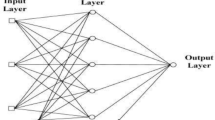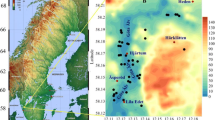Abstract
Precise determination of engineering properties of soil is essential for proper design and successful construction of any structure. The conventional methods for determination of engineering properties are invasive, costly, and time-consuming. Geoelectrical survey is a very attractive tool for delineating subsurface properties without soil disturbance. Proper correlations of various soil parameters with electrical resistivity of soil will bridge the gap between geotechnical and geophysical engineering and also enable geotechnical engineers to estimate geotechnical parameters from electrical resistivity data. The regression models of relationship between electrical resistivity and various soil properties used in the current research for the purpose of comparison with artificial neural network (ANN) models were adopted from the work of Siddiqui and Osman (Environ Earth Sci 70:259–26, 2013). In order to obtain better relationships, ANN modeling was done using same data as regression analysis. The neural network models were trained using single input (electrical resistivity) and single output (i.e., moisture content, plasticity index, and friction angle). Twenty (20) multilayer feedforward (MLFF) networks were developed for each properties, ten (10) each for two different learning algorithms, Levenberg-Marquardt (LM) and scaled conjugate gradient (SCG). The numbers of neurons in hidden layer were experimented from 1 to 10. Best network with particular learning algorithm and optimum number of neuron in hidden layer presenting lowest root mean square error (RMSE) was selected for prediction of various soil properties. ANN models show better prediction results for all soil properties.













Similar content being viewed by others
References
Abu-Hassanein ZS, Benson CH, Blotz LR (1996) Electrical resistivity of compacted clays. J Geotech Eng ASCE 122:397–406
Abu-Zeid N, Botteon D, Cocco G, Santarato G (2006) Non-invasive characterisation of ancient foundations in Venice using the electrical resistivity imaging technique. NDT E International 39:67–75
Anderson JA (2003) An introduction to neural networks. Prentice Hall
Arora T, Ahmed S (2011) Characterization of recharge through complex vadose zone of a granitic aquifer by time-lapse electrical resistivity tomography. J Appl Geophys 73:35–44
Braga A, Malagutti W, Dourado J, Chang H (1999) Correlation of electrical resistivity and induced polarization data with geotechnical survey standard penetration test measurements. J Environ Eng Geophys 4:123–130
Bristow KL, Kluitenberg GJ, Goding CJ, Fitzgerald TS (2001) A small multi-needle probe for measuring soil thermal properties, water content and electrical conductivity. Comput Electron Agric 31:265–280
Cosenza P, Marmet E, Rejiba F, Jun Cui Y, Tabbagh A, Charlery Y (2006) Correlations between geotechnical and electrical data: a case study at Garchy in France. J Appl Geophys 60:165–178
Das SK, Basudhar PK (2008) Prediction of residual friction angle of clays using artificial neural network. Eng Geol 100:142–145
Demuth H, Beale M, Hagan M (2006) Neural Network Toolbox User’s Guide. The Math Works, Inc., Natick
Erzin Y, Rao BH, Patel A, Gumaste SD, Singh DN (2010) Artificial neural network models for predicting electrical resistivity of soils from their thermal resistivity. Int J Therm Sci 49:118–130
Giao PH, Chung SG, Kim DY, Tanaka H (2003) Electric imaging and laboratory resistivity testing for geotechnical investigation of Pusan clay deposits. J Appl Geophys 52:157–175
Hassoun MH (1995) Fundamental of Artificial Neural Networks. MIT Press, Cambridge
Jha GK (2007) Artificial neural networks and its applications
Kalinski RJ, Kelly WE (1993) Estimating water content of soils from electrical resistivity. Geotech Test J 16:323–329
Kalinski RJ, Kelly WE (1994) Electrical-resistivity measurements for evaluating compacted-soil liners. J Geotech Eng ASCE 120:451–457
Liu SY, Du YJ, Han LH, Gu MF (2008) Experimental study on the electrical resistivity of soil-cement admixtures. Environ Geol 54:1227–1233
Majumdar RK, Majumdar N, Mukherjee AL (2000) Geoelectric investigations in Bakreswar geothermal area, West Bengal, India. J Appl Geophys 45:187–202
McCarter WJ (1984) Electrical resistivity characteristics of compacted clays. Geotechnique 34:263–267
Nijland W, van der Meijde M, Addink EA, de Jong SM (2010) Detection of soil moisture and vegetation water abstraction in a Mediterranean natural area using electrical resistivity tomography Catena
Oh S, Sun CG (2008) Combined analysis of electrical resistivity and geotechnical SPT blow counts for the safety assessment of fill dam. Environ Geol 54:31–42
Ozcep F, Tezel O, Asci M (2009) Correlation between electrical resistivity and soil-water content: Istanbul and Golcuk International. J Phys Sci 4:362–365
Ozcep F, Yildirim E, Tezel O, Asci M, Karabulut S (2010) Correlation between electrical resistivity and soil-water content based artificial intelligent techniques International. J Phys Sci 5:47–56
Panthulu TV, Krishnaiah C, Shirke JM (2001) Detection of seepage paths in earth dams using self-potential and electrical resistivity methods. Eng Geol 59:281–295
Pozdnyakov AI, Pozdnyakova LA, Karpachevskii LO (2006) Relationship between water tension and electrical resistivity in soils. Eurasian Soil Sci 39:S78–S83
Pozdnyakova A, Pozdnyakova L (2002) Electrical fields and soil properties Proceedings of 17th World Congress of Soil Science, Thailand, 14–21 August paper 1558
Samouëlian A, Cousin I, Tabbagh A, Bruand A, Richard G (2005) Electrical resistivity survey in soil science: a review. Soil Tillage Res 83:173–193
Santarato G, Ranieri G, Occhi M, Morelli G, Fischanger F, Gualerzi D (2011) Three-dimensional electrical resistivity tomography to control the injection of expanding resins for the treatment and stabilization of foundation soils. Eng Geol 119:18–30
Schwartz BF, Schreiber ME, Yan T (2008) Quantifying field-scale soil moisture using electrical resistivity imaging. J Hydrol 362:234–246
Séger M, Cousin I, Frison A, Boizard H, Richard G (2009) Characterisation of the structural heterogeneity of the soil tilled layer by using in situ 2D and 3D electrical resistivity measurements. Soil Tillage Res 103:387–398
Shahin MA, Jaksa MB, Maier HR (2001) Artificial neural network applications in geotechnical engineering. Aust Geomech 36:49–62
Siddiqui FI, Osman SBABS (2012a) Electrical resistivity based non-destructive testing method for determination of soil’s strength properties. Adv Mater Res 488:1553–1557
Siddiqui FI, Osman SBABS (2012b) Integrating geo-electrical and geotechnical data for soil characterization international. J Appl Phys Math 2:104–106
Siddiqui FI, Osman SBABS (2013) Simple and multiple regression models for relationship between electrical resistivity and various soil properties. Environ Earth Sci 70:259–267
Sjödahl P, Dahlin T, Johansson S, Loke MH (2008) Resistivity monitoring for leakage and internal erosion detection at Hällby embankment dam. J Appl Geophys 65:155–164
Son Y, Oh M, Lee S (2009) Estimation of soil weathering degree using electrical resistivity. Environ Earth Sci 59:1319–1326
Sreedeep S, Reshma AC, Singh DN (2005) Generalized relationship for determining soil electrical resistivity from its thermal resistivity. Exp Thermal Fluid Sci 29:217–226
Yoon GL, Park JB (2001) Sensitivity of leachate and fine contents on electrical resistivity variations of sandy soils. J Hazard Mater 84:147–161
Acknowledgments
This research study is supported by Universiti Teknologi PETRONAS under Graduate Assistantship scheme.
Author information
Authors and Affiliations
Corresponding author
Rights and permissions
About this article
Cite this article
Siddiqui, F.I., Pathan, D.M., Osman, S.B.A.B.S. et al. Comparison between regression and ANN models for relationship of soil properties and electrical resistivity. Arab J Geosci 8, 6145–6155 (2015). https://doi.org/10.1007/s12517-014-1637-y
Received:
Accepted:
Published:
Issue Date:
DOI: https://doi.org/10.1007/s12517-014-1637-y




